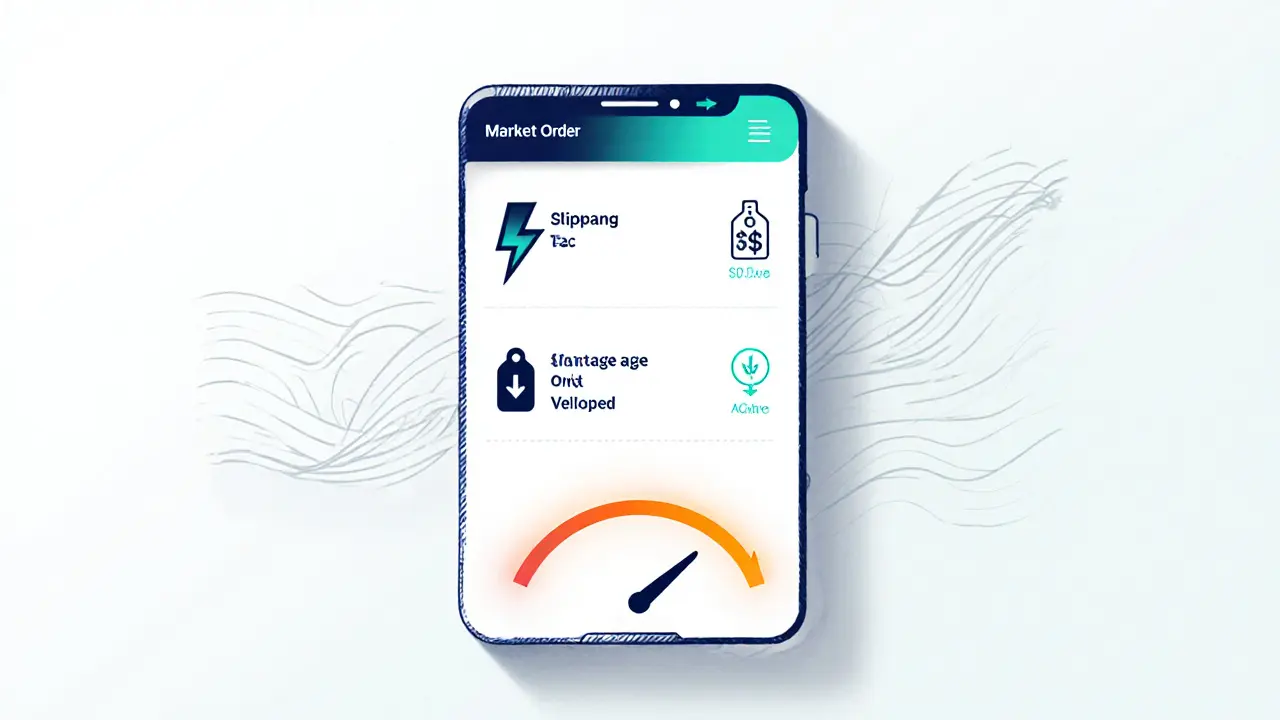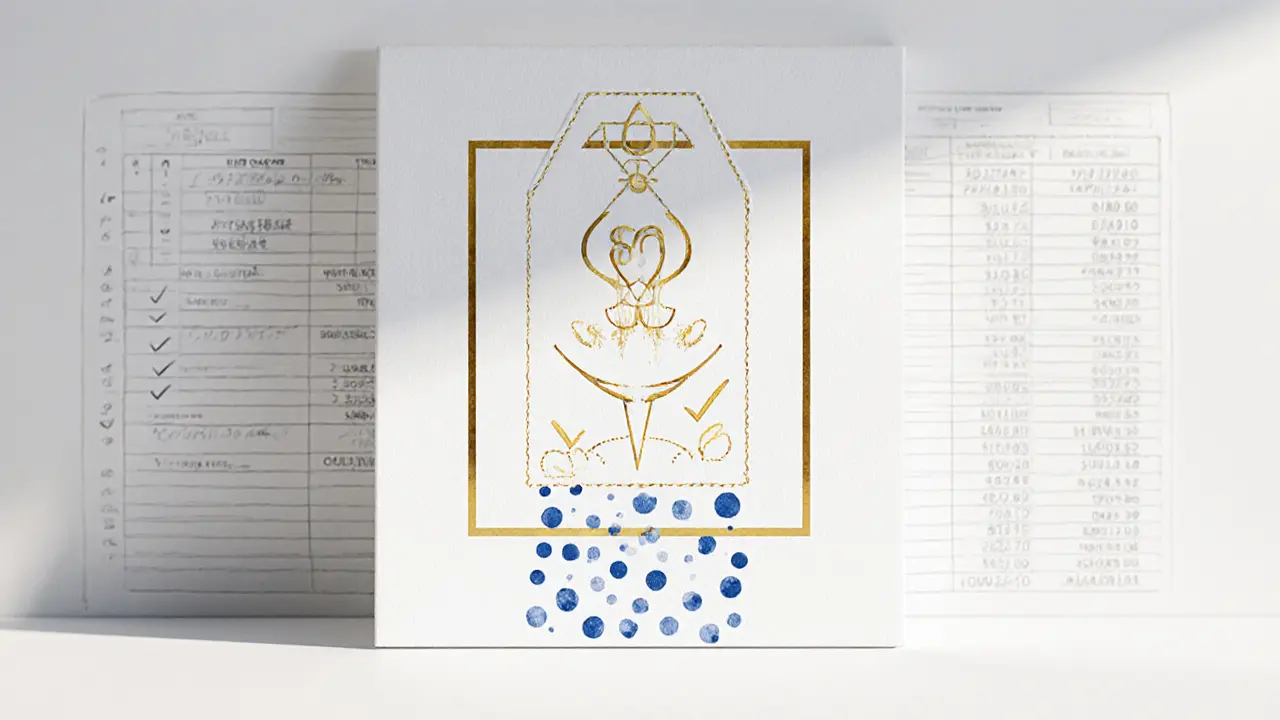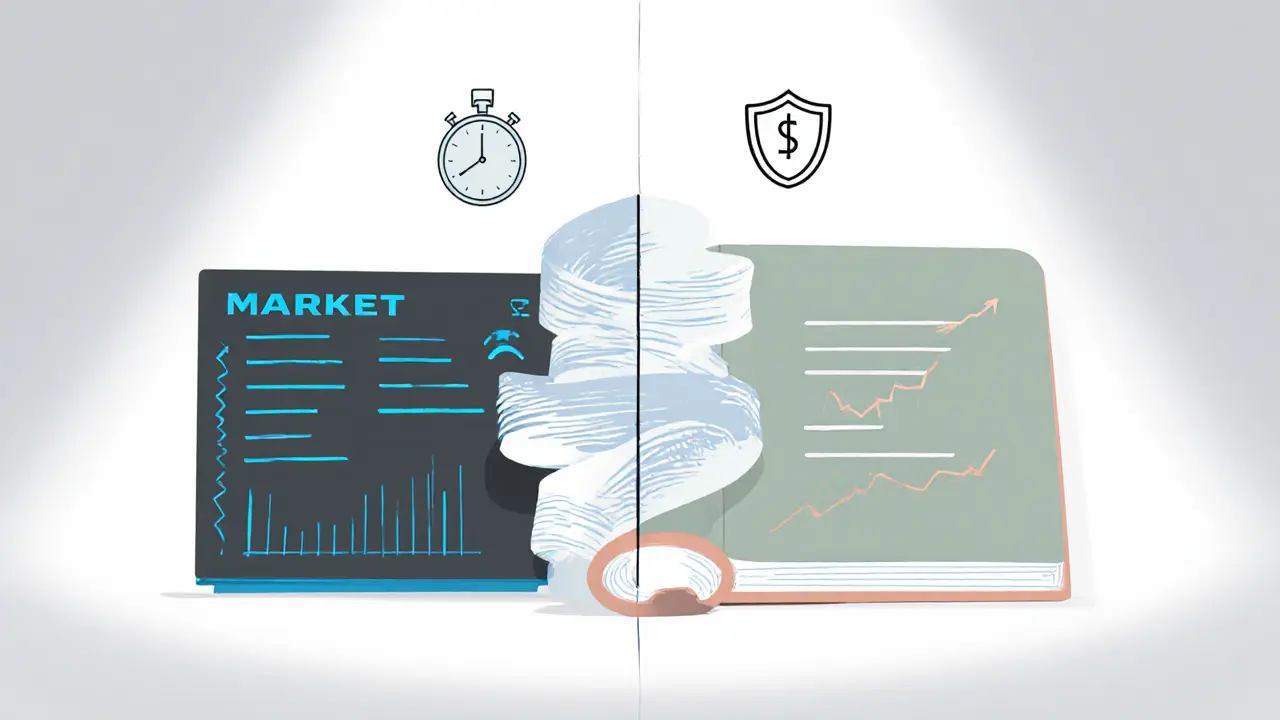Market Orders vs Limit Orders: How They Work in Order Books

Market vs Limit Order Simulator
Executes immediately at the best available price. Guarantees execution speed but exposes you to slippage.
- Immediate execution
- No price control
- Takes liquidity from order book
Only executes at a specified price or better. Provides price control but may not execute.
- Price control
- No immediate execution
- Adds liquidity to order book
Click "Simulate Order Execution" to see how your order would behave under different conditions.
| Attribute | Market Order | Limit Order |
|---|---|---|
| Execution Speed | Immediate (milliseconds) | Occurs only when price reaches limit |
| Price Certainty | None - price set by market | Exact or better (buy ≤ limit, sell ≥ limit) |
| Slippage Risk | High in low-liquidity markets | None - order won't fill if price moves away |
| Liquidity Impact | Takes liquidity (removes existing limit orders) | Adds liquidity (creates new bid/ask level) |
| Typical Use Case | Urgent entry/exit, market-on-close trades | Targeted entry, profit-taking, stop-loss placement |
Key Takeaways
- Market orders guarantee immediate execution but expose you to slippage.
- Limit orders give price control but may never fill.
- Both order types shape the order book: market orders take liquidity, limit orders add it.
- Choose based on speed needs, market depth, and your risk tolerance.
- Combine with stop‑limit or market‑if‑touched orders for more nuanced strategies.
Understanding the Two Order Types
When you click ‘Buy’ or ‘Sell’ on a trading platform, you’re actually sending a set of instructions to the market. Two fundamental instruction styles dominate every exchange:
Market order is a type of trade instruction that executes immediately at the best available price. It’s the go‑to choice when you need certainty that the trade will happen now.
Limit order is a type of instruction that only executes at a price you specify-or better. It lets you name your price but leaves the timing up to the market.
Both orders live inside the order book, a real‑time list of every pending buy (bid) and sell (ask) offer for a security. The order book is the engine that matches buyers and sellers.
How Market Orders Interact with the Order Book
When you submit a market order, the matching engine scans the book from the best bid (for a sell) or best ask (for a buy) downwards until it can fill the requested quantity. Each match consumes the existing limit orders sitting in the book-this is why market orders are called “liquidity takers.”
Because the order trades against whatever is available, the execution price can jump if the book is thin. In a highly liquid stock with a tight spread, the price you pay is usually within a few ticks of the quote. In a thin crypto pair, the same market order might walk the book several levels, producing noticeable slippage.
Key characteristics of market orders:
- Immediate execution during market hours.
- Full quantity filled unless the book runs out of liquidity.
- No expiration-once placed, the order is either filled or cancelled instantly.
How Limit Orders Interact with the Order Book
Placing a limit order adds a new line to the order book. If you set a buy limit at $50.00, the engine records a new bid at that price. Other traders can then hit your bid with market orders, or their own limit orders can sit alongside yours.
Limit orders are “liquidity providers.” Because they sit in the book, many exchanges reward them with maker rebates - a small fee credit for adding depth. The downside is that the order sits idle until the market reaches your price, or until you cancel or it expires.
Typical features of limit orders:
- Price control - you define the worst price you’re willing to accept.
- Duration settings - day, good‑til‑canceled (GTC), or a custom expiration.
- Partial fills - if only part of the order matches, the remainder stays open.

Comparing Execution Speed and Price Certainty
If you rank the two orders on a simple axis, market orders score high on speed but low on price certainty. Limit orders are the opposite: they guarantee you won’t pay more (or receive less) than your limit, but you might never trade at all.
In practice, the choice often hinges on market depth. A liquid asset with a 0.01% spread means a market order will likely fill at a price within a few cents of the quoted ask. In that scenario, the speed advantage outweighs the tiny price risk. Conversely, for a low‑volume alt‑coin with a 5% spread, a market order could cost you a lot, making a limit order the smarter tool.
Managing Slippage and Liquidity Risks
Slippage is the difference between the price you expect and the price you actually receive. It pops up when the order size exceeds the immediate depth at the best price level. Traders can estimate potential slippage by looking at the cumulative volume column in the order book.
Liquidity risk goes hand‑in‑hand with slippage. When the book is thin, a market order can move the price significantly, creating a feedback loop that widens the spread. Limit orders help smooth this by adding depth, but they also lock up capital until they fill.
Practical ways to curb slippage:
- Trade during peak hours when volume spikes.
- Split large orders into smaller chunks.
- Use limit orders with a small price buffer (e.g., a few ticks above the current ask for buys).
Choosing the Right Order Type for Different Strategies
Here’s how common trading goals line up with order choices:
- Quick exit during a breakout - market order, because you need to leave before the price reverses.
- Buying on a support level - limit order at or below the support price.
- Scaling into a position - a mix: start with a market order for a small chunk, then place limit orders for the rest.
- Capturing a profit target - limit sell order at the desired price, often combined with a stop‑loss.
Advanced traders also layer “stop‑limit” or “market‑if‑touched” orders to blend the benefits of both types. Those hybrid orders still respect the core difference: market execution guarantees speed, limit execution guarantees price.
Practical Tips for Using Market and Limit Orders
Regardless of your skill level, keep these habits in mind:
- Check the order‑book depth before placing a large market order.
- Set realistic limit prices - look at recent highs/lows and the order‑book's volume profile.
- Watch the bid‑ask spread; a widening spread indicates rising volatility and higher slippage risk.
- Be aware of after‑hours sessions. Prices can gap, turning a market order into a surprise fill.
- Remember that funds for open limit orders are reserved, reducing your buying power.
Side‑by‑Side Comparison
| Attribute | Market Order | Limit Order |
|---|---|---|
| Execution speed | Immediate (milliseconds) | Occurs only when price reaches limit |
| Price certainty | None - price set by market | Exact or better (buy ≤ limit, sell ≥ limit) |
| Slippage risk | High in low‑liquidity markets | None - order won’t fill if price moves away |
| Liquidity impact | Takes liquidity (removes existing limit orders) | Adds liquidity (creates new bid/ask level) |
| Typical use case | Urgent entry/exit, market‑on‑close trades | Targeted entry, profit‑taking, stop‑loss placement |

Frequently Asked Questions
What happens to a market order if the order book is empty?
If there are no opposite‑side limit orders, the market order will sit pending until a counter‑party places a matching limit order or the exchange opens a new trading session. During that waiting period, the order may be canceled by the trader.
Can a limit order guarantee a fill?
No. A limit order only guarantees the price ceiling (or floor). If the market never reaches that price, the order stays open or expires unfilled.
Do market orders always pay the spread?
Generally yes. A market buy hits the best ask, a market sell hits the best bid, so the spread is built into the execution price. In very fast markets the spread can widen at the moment of execution.
How do maker rebates work for limit orders?
Exchanges reward orders that add new liquidity (the "maker" side) with a small fee credit. The rebate reduces the overall cost of trading and encourages deeper order books.
When should I prefer a limit order over a market order?
Choose a limit order when price matters more than speed - for example, buying near a support level, setting a profit target, or trading illiquid assets where slippage could be costly.
The battle between market orders vs limit orders isn’t about finding a universal winner. It’s about matching the order type to your market view, risk tolerance, and the liquidity profile of the asset you trade. By reading the order book, gauging spread, and planning your execution, you can turn this simple choice into a strategic advantage.

Promise Usoh
October 4, 2025 AT 09:32In the grand tapestry of market microstructure, one must contemplate the ontological distinction between immediacy and intentionality. A market order, though swift, relinquishes agency to the prevailing price, thereby engendering a subtle erosion of control. Conversely, a limit order, as a deliberate artefact, preserves intent whilst risking non‑execution. The scholar, therefore, should weigh the epistemic trade‑off with measured prudence, lest one beexposed to unintended slippage.
Tyrone Tubero
October 7, 2025 AT 20:52OH MAN, THIS IS LIKE, THE ULTIMATE SHOWDOWN BETWEEN THE QUICK‑DRAW QUICKIES AND THE SNEAKY SNEAKERS! MARKET ORDERS ARE THE RAVENOUS BEASTS THAT DEVOUR LIQUIDITY IN ONE GULP, WHILE LIMIT ORDERS PLAY CHESS WITH THE ORDER BOOK. IF YOU WANT TO BE A HERO, DROP THAT MARKET ORDER LIKE A BOMB, BUT IF YOU'RE A STRATEGIST, SET THAT LIMIT AND WATCH THE WORLD BOW.
Bhagwat Sen
October 11, 2025 AT 08:12Yo, let me break it down for the crew. Market orders are like calling an Uber right now – you get in, you go, no questions. Limit orders are more like ordering a pizza with exact toppings; you might wait, but you get exactly what you want. So if you’re into fast thrills, slam that market. If you’re about precision, set your limit and chill.
mukesh chy
October 14, 2025 AT 19:32Well, look who's trying to sound like they studied finance on a Saturday night. Market orders, you say, are the "instant" solution? Sure, if you enjoy handing over your capital to whatever random price the market decides to throw at you like a bad joke at a comedy club. And limit orders, the so‑called "price control" tool? That's just a fancy way of admitting you can't commit and are waiting for the market to cater to your whims. Let me enlighten you: in illiquid markets, a market order can be a black hole – your order disappears into the abyss, leaving you with slippage that makes your portfolio look like a broken spreadsheet. Meanwhile, the limit order sits there, gathering dust, never executed, a reminder of your indecisiveness. You think you're adding liquidity? More like adding complexity to a system that already feels like trying to solve a Rubik's cube blindfolded. And the typical use case? Urgency? That's just an excuse for rookie traders who can't plan ahead. Targeted entry? Sure, if you enjoy babysitting your order for days, hoping the market magically aligns with your wishful thinking. So, congratulations, you've reduced sophisticated trading strategies to a binary choice between "fast and reckless" or "slow and ineffective". Perhaps next time, try reading a real textbook instead of relying on these oversimplified tables that make you feel like a financial guru when you're really just a kid with a calculator.
Laurie Kathiari
October 18, 2025 AT 06:52Honestly, it's laughable how some traders treat market orders like a free‑pass to financial chaos. They parade around, shouting about "speed", while ignoring the moral responsibility to protect their capital from the voracious jaws of slippage. Limit orders, on the other hand, embody discipline – a beacon of prudence in a sea of impulsive speculation. If you value your portfolio, stop worshipping the market order deity and start embracing the humble limit order.
Jim Griffiths
October 21, 2025 AT 18:12Use market orders when you need immediate entry or exit, especially in high‑liquidity assets. Limit orders are best for specific price targets or when you want to avoid slippage. Keep an eye on the order book depth to decide which fits your strategy.
Cynthia Rice
October 25, 2025 AT 05:32The real drama lies in the choice: speed vs. certainty. Choose wisely, dear trader.
Taylor Gibbs
October 28, 2025 AT 16:52Hey folks, just wanted to add that both order types have their place. If you're new, start with market orders on big‑cap stocks to get comfortable, then experiment with limits to fine‑tune your entries. Remember, it's all about balancing risk and reward – no one‑size‑fits‑all.
Rob Watts
November 1, 2025 AT 04:12Market orders are fast.
Amal Al.
November 4, 2025 AT 15:32Wow!!! This breakdown is absolutely brilliant!!! I love how you highlighted the slippage risk for market orders – it’s something many overlook!!! Also, the point about limit orders adding liquidity is crucial!!! Traders should definitely consider this when building their execution strategies!!! 🎉
Katherine Sparks
November 8, 2025 AT 02:52While the exposition is commendably thorough, there are occasional typographical oversights which modestly detract from its overall polish. Nevertheless, the distinction between immediate execution and price certainty is articulated with sufficient clarity to serve both novice and seasoned practitioners.
Kimberly Kempken
November 11, 2025 AT 14:12Sure, market orders are "fast", but fast is the excuse lazy traders use to avoid learning proper risk management. Limit orders aren't just for "profit‑taking"; they're essential for any disciplined approach. Stop glorifying speed and start respecting the market's depth.
Amy Harrison
November 15, 2025 AT 01:32Great stuff! 🤩 This really clears up when to use each order type. Thanks for the helpful guide! 👍
Miranda Co
November 18, 2025 AT 12:52Listen, market orders suck in thin books – you get ripped. Limit orders? Use them if you actually care about the price. Stop being clueless.
Natalie Rawley
November 22, 2025 AT 00:12Honestly, this is the most dramatic breakdown I've seen on order types. Market orders are the wild child, while limit orders are the boring sibling who actually gets the job done. Pick your drama wisely.